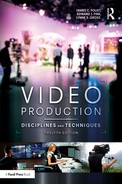Book Description
The revised twelfth edition of Video Production: Disciplines and Techniques introduces readers to the operations underlying video production. It provides thorough coverage of the theory and techniques readers need to know, balancing complexity with practical how-to information about detailed subjects in a concise, conversational style. The book has been updated to incorporate recent changes in the video production pipeline—emphasizing digital video, non-linear video production, streaming platforms, and mobile production—while maintaining the foundational, nuanced, teamwork-based approach that has made the book popular.
Each chapter includes key takeaways, review questions, and on-set exercises, and a comprehensive glossary defines all the key production terms discussed. An accompanying eResource includes downloadable versions of the forms and paperwork used in the book, in addition to links to further online resources.
